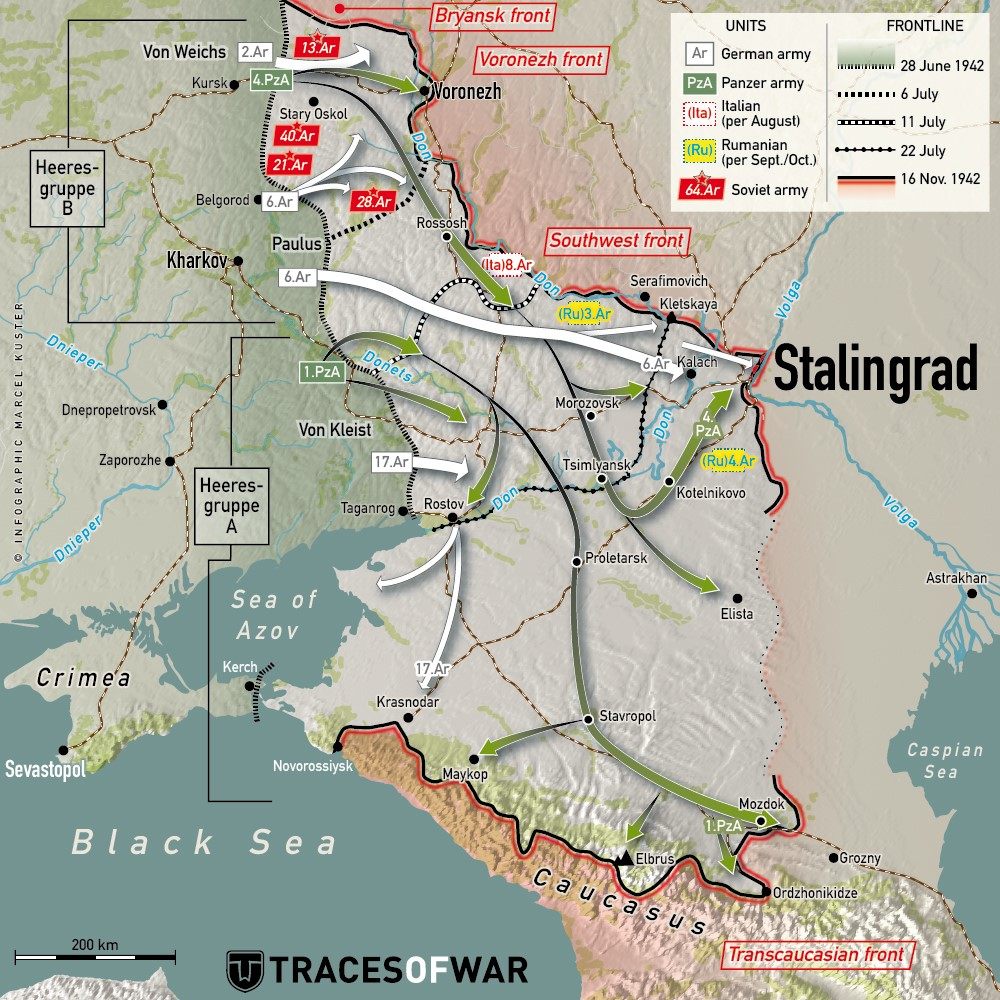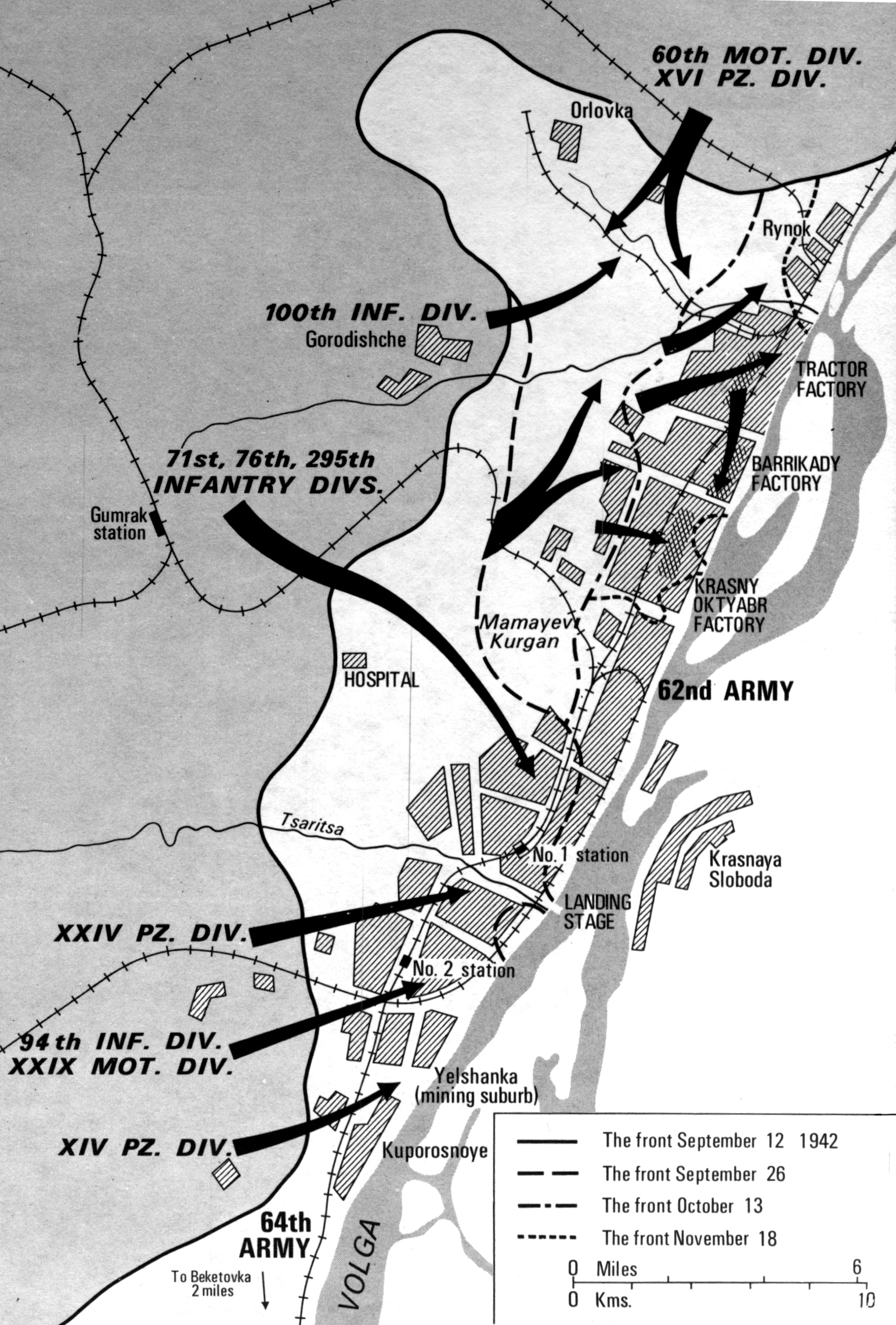Battle of Stalingrad - GE/TT
Pearl Harbor - Battle of Midway - Battle of Stalingrad - D-Day - Battle of the Bulge GE-TT
The following information




The success of these attacks caused much of the German army to collapse and an entire group, the 6th German Army, to be cut off and surrounded inside Stalingrad. The fighting became a house to house conflict where the soldiers fought in buildings and streets that had been destroyed.
3,500 tanks and self-propelled (move on their own) guns destroyed
12,000 guns and mortars destroyed
3,000 aircraft destroyed
Stalingrad:
July 17th , 1942 – February 2nd, 1943
Where It Was

Stalingrad is in the southern part of the Soviet Union

Stalingrad was a target because it had a lot of factories
How bad it would get in Stalingrad before it was all over:
"I watched my mother and father die. I knew perfectly well that they were starving. But I wanted their bread more than I wanted them to stay alive. And they knew that. That’s what I remember about the blockade: that feeling that you wanted your parents to die because you wanted their bread."
-Soviet Soldier in Stalingrad
-Soviet Soldier in Stalingrad
Hardship: 478,741 soldiers killed or missing; 650,878 soldiers wounded and sick; 40,000 civilians dead; 4,341 tanks destroyed; 15,728 guns and mortars destroyed; 2,769 combat aircraft demolished.
Germany had tried to invade the Soviet Union the year before, and been stopped. Spring and then Summer had come in 1942, and the Germans made it clear they had not given up after being stopped in December. They tried again.
The white and green lines show how the German army moved to Stalingrad when they started again after the Winter of 1941-1942.
Why Attack Stalingrad ?:
The capture of Stalingrad was important to Adolf Hitler, and Benito Mussolini, for this reason:
- The city was an important center for transportation. If the Germans could capture Stalingrad they would hurt the Soviet ability to send supplies and people from one place to another to fight them.
They also felt that if they could keep moving in this area they would capture areas that produced oil, which would keep fuel from the Soviet army.

These towers were used to pump oil from the ground which was used to make fuel for planes, trucks, and tanks. This was what the Germans wanted to get.
What Happened:
The German attack to capture Stalingrad started in late summer 1942, supported by heavy Luftwaffe bombing which reduced much of the city to rubble. The German attack eventually slowed down in house-to-house fighting, and despite controlling over 90% of the city at times, the German army was unable to get rid of the last Soviet defenders holding desperately on.
The Soviets were holding on in the small space where all of the arrows, which stand for German attacks, are going.
In November 1942, the Red Army (Soviet Union Army) launched Operation Uranus; a two-pronged attack specifically targeted at the Romanian and Italian (they were weaker and not as skilled as the Germans) forces protecting the German 6th Army flanks (sides).

This map shows the Soviets attacking from above and below Stalingrad, and trapping the Germans there.
The success of these attacks caused much of the German army to collapse and an entire group, the 6th German Army, to be cut off and surrounded inside Stalingrad. The fighting became a house to house conflict where the soldiers fought in buildings and streets that had been destroyed.
Soviet soldiers fighting in the streets around buildings that had been destroyed. See the one jumping out of the side of a hole in the wall???
As the Russian winter set in, the German 6th Army weakened rapidly from cold, starvation and constant Soviet attacks. The fighting got so bad that at times they would do battle in the sewers underground. Men would kill each other with pistols, knives, clubs, and brass knuckles. The Germans took to calling in Rattenkrieg which means fighting in very nasty conditions, including in sewers where rats live.


German soldiers fighting in the Stalingrad sewers
Adolph Hitler refused to allow the German army to retreat, or to try to break out of the Soviet army circle that was around them. They were doomed when it proved impossible to get supplies to them by airplane. By early February 1943, Germans in Stalingrad had either stopped fighting and surrendered or had been destroyed.
What It Meant:
For Germany:
Men:
- 750,000 men killed, missing or wounded
- 91,000 captured
These men could not be replaced after already being at war for four years.
Equipment:
12,000 guns and mortars destroyed
3,000 aircraft destroyed
This amounted to almost half a year’s worth of the weapons German companies could make. It could not be replaced fast enough.
For The Soviet Union:
Men:
Yes, they had lost over 1 million killed, but it did not matter. They were a large country, and had a lot of men that could be sent into battle.
Equipment:
It did not matter here either. They were getting weapons from the U.S., and their factories were making massive numbers of all kinds of weapons.




Comments
Post a Comment